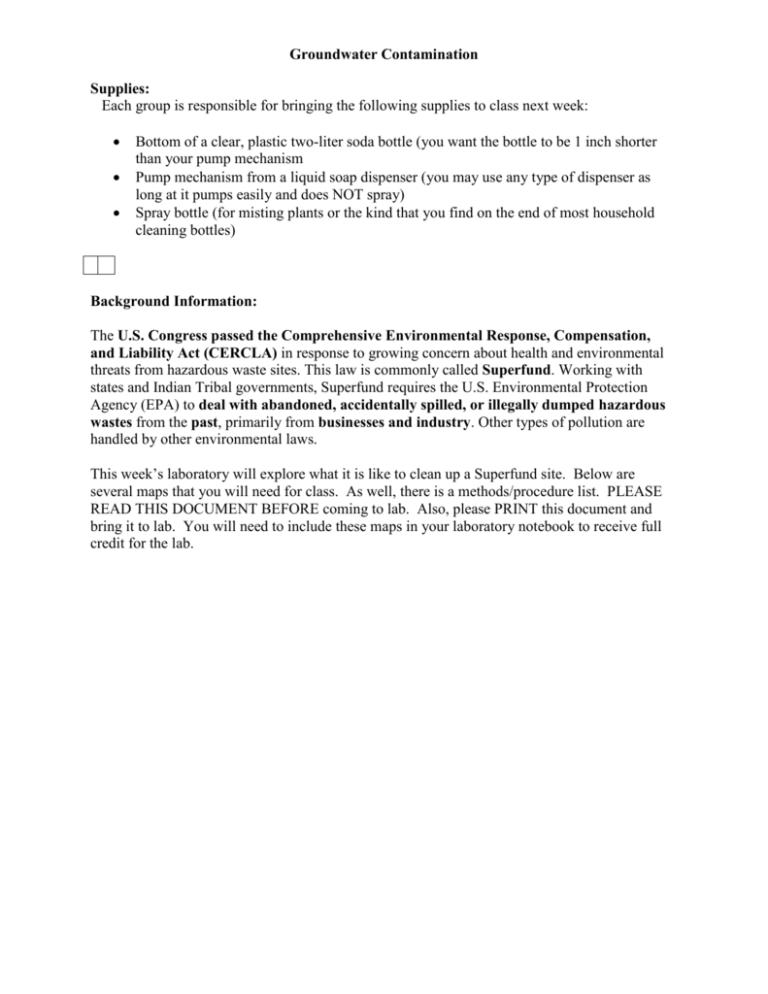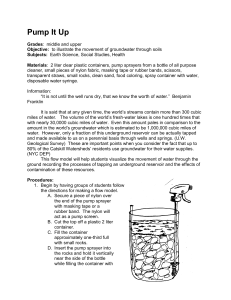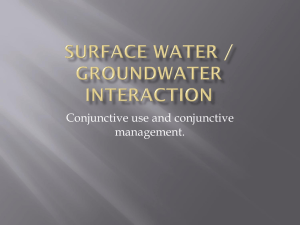Groundwater Contamination
advertisement

Groundwater Contamination Supplies: Each group is responsible for bringing the following supplies to class next week: Bottom of a clear, plastic two-liter soda bottle (you want the bottle to be 1 inch shorter than your pump mechanism Pump mechanism from a liquid soap dispenser (you may use any type of dispenser as long at it pumps easily and does NOT spray) Spray bottle (for misting plants or the kind that you find on the end of most household cleaning bottles) Background Information: The U.S. Congress passed the Comprehensive Environmental Response, Compensation, and Liability Act (CERCLA) in response to growing concern about health and environmental threats from hazardous waste sites. This law is commonly called Superfund. Working with states and Indian Tribal governments, Superfund requires the U.S. Environmental Protection Agency (EPA) to deal with abandoned, accidentally spilled, or illegally dumped hazardous wastes from the past, primarily from businesses and industry. Other types of pollution are handled by other environmental laws. This week’s laboratory will explore what it is like to clean up a Superfund site. Below are several maps that you will need for class. As well, there is a methods/procedure list. PLEASE READ THIS DOCUMENT BEFORE coming to lab. Also, please PRINT this document and bring it to lab. You will need to include these maps in your laboratory notebook to receive full credit for the lab. You will be asked to think about the following questions in class. Please record your thoughts (in class) in your notebook. HOW might contaminants spread from the site? HOW might animals or plants may be exposed to contaminants from the site? HOW people in Ruralville and Utopia may be exposed to contaminants from the site? WHAT factors would affect the amount of exposure from site contamination? Groundwater contamination is a major concern in the Superfund Program, and it is difficult to visualize how contaminants move underground. We are going to construct a small groundwater model to explore how groundwater and contaminants move in an aquifer. You will be separated into 5 groups. Each group will make a different model: (1) use red food coloring to simulate a water-soluble contaminant; (2) use the buried paper towel described in the note and illustration on previous page; and (3) use maple syrup to simulate a DNAPL; (4) use vegetable oil to simulate an LNAPL; (5) use a buried paper towel saturated in vegetable oil. option 2 & 5 only 1. Building your aquifer. Tape the pump mechanism, with the nylon fabric attached, to the inside of the container so that the nylon-covered end of the tube almost touches the bottom of the container. o Fill the container about one-third full with the pebbles or gravel. o If you are doing option 2 or 5, bury your paper towel beneath the surface (in the gravel). The buried paper towel represents an abandoned waste site. Add water until 1/4 of the pump is submerged. Then spray more water on the surface until 1/2 the pump is under water. Observe. o If you are doing option 1, 3, or 4, spread out the coffee filter and, if necessary, cut the paper to make a circle with a diameter larger than the diameter of the inside of the container. Place the filter paper on top of the pebbles and tape it to the sides of the container. o Option 1, 3, or 4. Fill the rest of the container with sand. The filter paper will prevent the sand from falling down into the gravel and filling the spaces between gravel particles. Your groundwater model is now ready for conducting experiments. Perform the following steps. 2. Spray water on the sand with the spray bottle, until the sand is saturated. The water will filter down through the sand and into the gravel. Keep spraying until the water table (the top of the portion of the ground that is completely saturated with water) is in the sand. Keep track of the amount of water that the container can hold at your selected water table level. 3. Push down on the pump mechanism and slowly draw a little water from the gravel through the tube and out of the pump. Make sure the pump empties into the measuring cup. The pump mechanism creates a vacuum to draw out the water. This is essentially the same method used to pump groundwater from aquifers (underground rock materials that are capable of storing and transmitting water in useful amounts). 4. Spray more water on the sand until you reach your original water level. If you are doing options 1, 3, or 4, add a few drops of red food coloring, syrup, or oil on top of the sand. Place one of the drops near the edge of the sand, near the wall of the container. This represents a hazardous waste. The food coloring will dissolve in water, similar to gasoline; the other two substances will not (or will dissolve very slowly). If not, continue on to step 5. 5. Make it rain on your aquifer model by pumping the spray bottle 5 times. 6. Continue pumping water from the container into the measuring cup. The water in the cup will eventually have a reddish hue. Keep track of how much water you have to pump from your groundwater model. Notice how the pollutant at the surface level has contaminated the groundwater. This is similar to rainwater carrying contaminants underground and into an aquifer. Make any observations about how the pollutant moves downward through the sand from the drop placed by the wall of the container. 7. Estimate how much clean water will have to be sprayed onto the sand to remove all of the food coloring/syrup/ oil. Record this amount in your laboratory notebook. Continue adding water to the sand and removing water with the pump until you believe that the groundwater has been cleaned up. How much water did it take to clean the aquifer? Was this close to what you guessed? Go around the class. Look the other models. Ask each group about their results. We will discuss. In your conclusion (in your lab notebook), note some of the differences among the groups. As well, answer the following questions: HOW does your small groundwater model represent contamination at a Superfund site? WHAT is different between your experimental groundwater model and a real Superfund site? Consider the situation at the fictional Flowing Railroad site. Would the residents of Utopia be in greater danger from contaminated groundwater if the groundwater beneath the Flowing Railroad site was flowing north toward Utopia or south away from Utopia?









